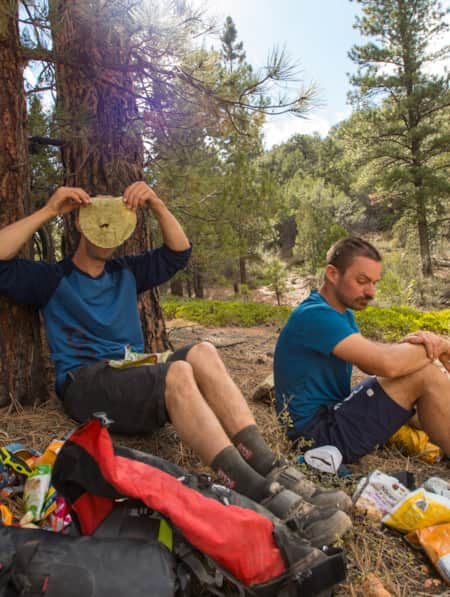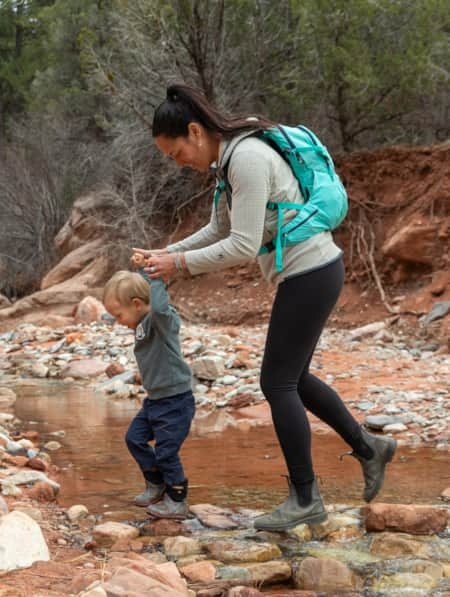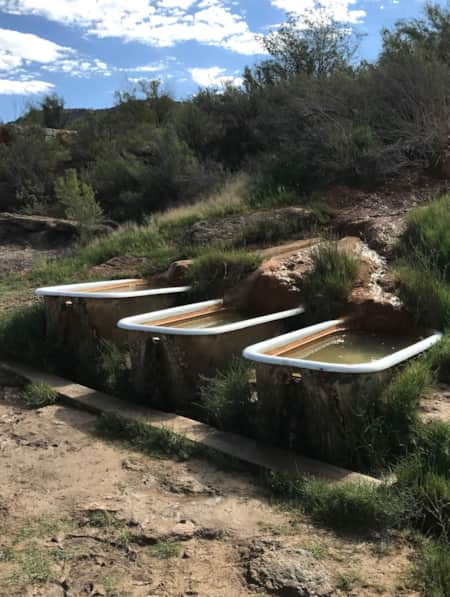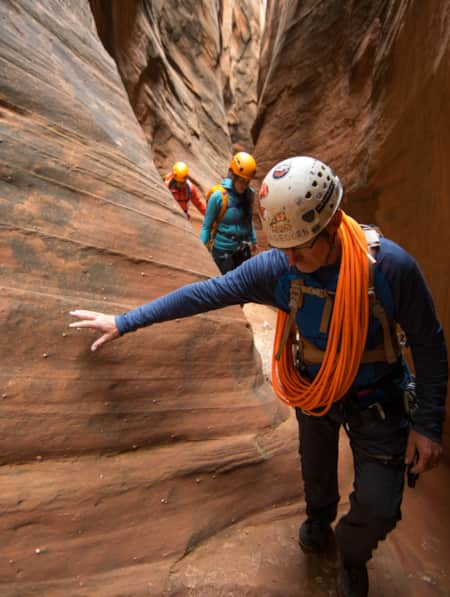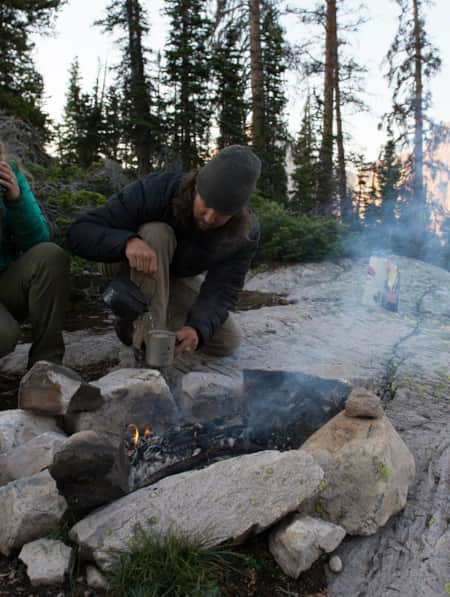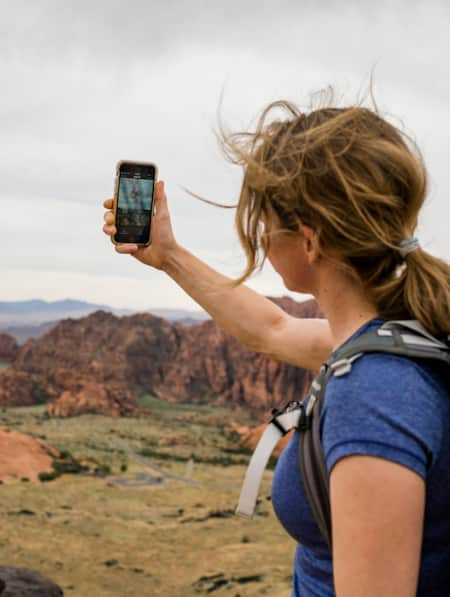A Van Lifer’s Guide to Responsible Travel in Southern Utah
Here’s what you need to know to travel safely, support Utah’s rural communities, and help preserve the delicate desert landscape.

With more than 35 million acres of public lands, dirt roads galore, and plenty of room to spread out, there’s no place like Utah for van lifers. Hiking, biking, canyoneering, rafting, climbing — the outdoor opportunities here are endless, only to be topped off with Utah’s unique landscapes found nowhere else in North America. Utah also has a variety of ecosystems, and as a van lifer, you can flock to where the sun is shining or where the snow is falling, depending on your preferences.
OK, maybe you’re convinced, but before you hit the open road for red rock country, there are a few important things you need to know. Here are some of my top tips for being a responsible van lifer, so you know how to travel safely, support Utah’s rural communities and preserve the sensitive ecological environments that you’ll find here.

With more than 35 million acres of public lands, dirt roads galore, and plenty of room to spread out, there’s no place like Utah for van lifers.

Porcupine Rim Trail
Photo: Kristen Bor
Know Before You Go
Before your trip, look up rules, regulations and possible reservation requirements for your specific destination. Land management agencies such as the Bureau of Land Management, National Park Service, U.S. Forest Service, tribal lands, as well as state and local agencies all have different rules, regulations and permit or reservation requirements. Some destinations within these agencies may differ as well. Following these regulations will help preserve the areas you visit and ensure a positive experience.
Find Your Own Slice of Paradise
Utah is well known and loved for its Mighty 5 national parks, Lake Powell, and the town of Moab. These places are absolutely worth a visit, but they can get very busy in peak season (Read: The Best Time to Visit Moab). You can avoid some of the crowds by traveling in the off-season (late fall through early spring), visiting national parks during off-hours, or by choosing lesser known destinations, such as the town of Kanab, Grand Staircase-Escalante National Monument or Fishlake National Forest.
I suggest utilizing paper maps and a satellite view on Google Maps to plan out a quiet route that is far off-the-beaten path. Also, if your van is equipped for it, the further you travel on dirt roads, the more solitude you will find.
Start exploring some of the best outdoor destinations in Utah.
Be Self-Sufficient
Services can be limited in rural Southern Utah across the state between I-15 and Highway 191. This means you’ll need to stock up on supplies in towns such as Salt Lake City, Price, Cedar City, St. George, or Moab before venturing out to the unknown. Same goes for drinking water and gas. Don’t hesitate to top off your gas tank if you don’t know how far it is until the next gas station.
Another thing to be aware of is cell service in these areas is non-existent, so make sure you have maps and information downloaded beforehand. I personally like to travel with a Garmin InReach when doing van life in Southern Utah. That way if I have any issues when I’m out of cell range, I can use my Garmin to send a text message or call for help.
If you decide to get off the pavement and explore Utah’s rocky dirt roads, you should have a jack, a spare tire and some basic recovery gear.
Always Leave No Trace
The desert is unmatched at its ability to withstand drought, high winds and crazy temperature swings, yet it is still one of the most fragile ecosystems on the planet.
Due to the dry climate, the Utah desert’s cryptobiotic soil and vegetation is super slow to grow, and can take hundreds or even thousands of years to reach maturity. Yet a single footprint (or tire track) can do irreparable damage. That means as van lifers who call Southern Utah their temporary home, we need to take extra care to protect this unique and incredible environment.
When choosing a campsite, only drive on established roads, camp in existing spots that have already been camped in and avoid trampling vegetation. If you don’t have a bathroom in your van, brush up on Leave No Trace principles for the desert. Some areas may allow catholes, while others may need you to pack out your waste using WAG (waste alleviation gel) or human waste disposal bags (Read: How to Poop in the Outdoors). Always pack out your used toilet paper, as well as your other garbage and microtrash you might find at your campsite.
Another principle of Leave No Trace is to leave any natural or archeological objects you might find. Utah is home to eight distinct tribal nations, including the Ute, Diné (Navajo), Paiute, Goshute and Shoshone. Tens of thousands of archeological sites exist in Utah, and if you happen to come across any archeological artifacts, don’t touch anything and leave things as you find them. Keep in mind that it’s illegal to disturb archeological sites or to remove artifacts, and the oils on your skin can also cause permanent damage, so enjoy with your eyes only.
Prepare for the Weather
Utah is very hot in the summer, and if you’re like most van lifers, you probably don’t have AC. If you are traveling with a pet, I’d highly recommend avoiding Southern Utah in July and August. If you choose to visit Utah in summer, I suggest bringing some sort of shade structure, and consider visiting higher elevation areas where it’s cooler.
Winter on the other hand, can be quite pleasant in Southern Utah and is the least crowded time to visit the national parks. However, you should be ready for snow, slick and icy trails, and for many dirt roads and campsites to be closed. Bring warm layers, lots of blankets for the evenings, and traction for your shoes if you’re hoping to get out and explore.
Support Local Communities
Many of Utah’s small communities rely on tourism, so supporting local during your travels can have a profound impact. Stock up with groceries locally, stop in an artisan shop or eat at a restaurant in addition to campfire meals. Need more ideas? Check out this article.
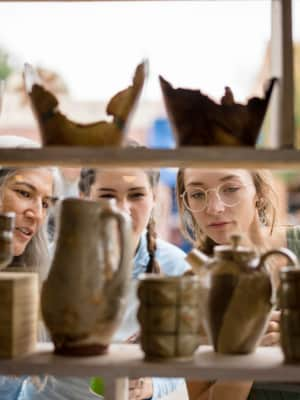
How to Support Local On Your Utah Road Trip
Many small businesses in Utah rely on tourism for survival. These expert tips help road trippers make a real difference in communities by supporting local.


